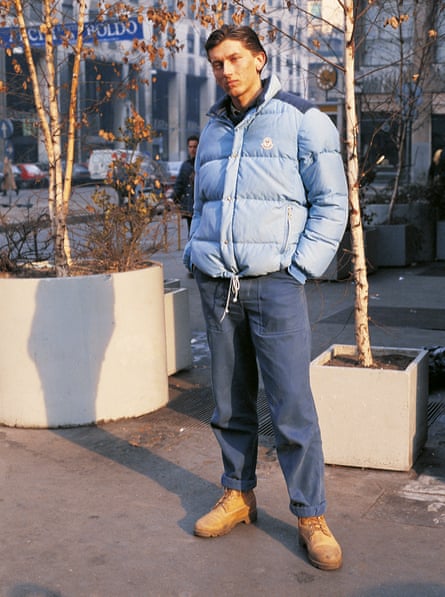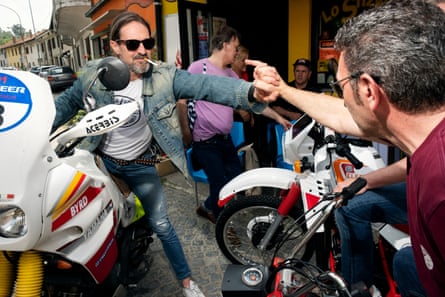On a sultry June afternoon the tables of a snack bar in Foglizzo, a small town in northern Italy, fill up with a dozen men riding motorbikes and dressed in colourful apparel. It’s a gang of paninari: a quintessentially Italian, once-dominant youth subculture.
Today, paninari are well into their 50s, and the group we meet in Foglizzo, as the town was celebrating its yearly courgette festival, are no exception. But despite the grey hairs and extra pounds that come with age, they still look smart in their typical paninari outfits, sporting Timberland boots, cowboy style belts and flashy sunglasses.
Their aesthetic, which combines designer clothes with country accessories, and revels in the deliberate ostentation of expensive brands, bloomed in the 1980s and defined the decade. They were rivals with other youth tribes like punks and metalheads, though as any Italian over 45 will tell you, the paninari outnumbered both. But despite the enormous popularity in the 80s – when they produced popular books, films and comics – the movement faded quickly, and by the early 1990s it was outside of the mainstream. The most hardcore believers, however, never renounced the faith: a small group of paninari kept the scene alive throughout the decades and, lately, has started to enjoy a resurgent popularity online.
“Being a paninaro, it’s not just about wearing certain clothes, but knowing how to wear them in a certain way,” says Ramon Verdoia, a driving school instructor who lives in a town near Turin, sipping a Coca-Cola and munching a panino. “It means adhering to a lifestyle.”
Paninari were rule breakers: in a country proud of its culinary tradition they ate hamburgers (the Italian fast-food outlet Burghy in Milan become one of the iconic places of this subculture), and in a land well known for bel canto they listened to Anglo-American pop singers like Duran Duran, whose song Wild Boys – occasionally Italianised as “uah-boee” – became their unofficial anthem. Other beloved artists included Culture Club, Cindy Lauper, Wham!, Madonna and Michael Jackson. Then there was Italo disco, made by Italian artists like Gazebo and Den Harrow, combining Italian melodic pop with synths: “Many pretended to be Americans and sang in English but they were from, let’s say, Milano,” Verdoia says.
In the paninari universe, Verdoia is a minor celebrity: he manages an online community and he has directed two films on paninari. Every year he organises one or more gatherings, attended by personalities from the 80s, plus many informal meetings like this one in Foglizzo.

Verdoia remembers perfectly the moment he decided to join the tribe, in 1984, when he was 14. “My friend Riccardo pointed out to me this boy dressed in a blue puffer jacket, high-waisted trousers and a pair of Nike Wimbledon shoes with a blue logo. He was different – the bright colours gave a sense of break with the greyness of those years.”
Writer Paolo Morando, author of the book ’80: L’inzio della Barbarie (’80: The Beginning of Barbarism), defines the paninari as part of major social change. While the 1970s were defined by political tensions, the 1980s in Italy brought disengagement and a return to private life. Italy enjoyed significant economic growth which allowed many to access goods that were previously out of reach. “You start to have a second car or a holiday home or, for example, the consumption of exotic fruit increases exponentially,” Morando says.
In this context, the Paninari presented themselves as the spirit of the time, a subculture of the winners, the cool guys who made money – or were good at giving the impression they did. At first, it was a rich boy’s club – the scene started in Milan’s wealthy city centre, around the snack bar Il Panino, hence the name – but eventually middle-class kids joined, even if it was beyond their budget.
“Dressing completely as a paninaro could cost as much as one million lire, a small fortune, and since they were kids they had to get the money from their parents,” says Giampiero Trolio, a 54-year-old paninaro who, in his civilian life, works as a computer engineer for a big corporation.
His outfit, like Verdoia’s and everyone’s else in the gang, looks like a time capsule: lots of hair gel, flashy sunglasses, high-waisted jeans and diamond-patterned socks (the latter are a true signature of the paninaro). A small crowd of lay-people has gathered staring at them. And, of course, at the bikes and scooters – all 1980s models: Yamaha, Ducati and Garelli – parked outside.

The paninari are often considered a rightwing subculture. To some extent this is true: some members have belonged to far-right groups, but Verdoia maintains it’s more complicated. Initially many paninari were an offshoot of the San Babilini, the young fascists who gathered in Milan’s Piazza San Babila, not far from the Il Panino bar. But as the scene grew it increasingly became apolitical, as Verdoia claims: “Those who were rightwingers were fashionable – some even were in the Youth Front [the youth wing of the now defunct neo-fascist party Social Movement]. But most parts of paninari are not interested in politics at all. In the end, a paninaro just wants to enjoy life, and for this reason they describe us as shallow.”
Around 1983, the paninari became a mass movement, the culture of Italy’s youth par excellence. They were mocked by a popular skit on national television, they had their own magazines and even a literary genre: the novel I Will Marry Simon Le Bon, written by teenager Clizia Gurrado, became a bestseller and was turned into a movie (though unfortunately Gurrado never actually married the Duran Duran frontman).
Paninari also caught the eyes of British band Pet Shop Boys, when they visited Milan to promote their debut album Please. Soon after they released Paninaro as the B-side of the single Suburbia, whose lyrics about pleasure, cars and Armani encapsulated their philosophy: “What I do like, I love passionately.” The band was never particularly beloved by the Paninari: “We were considered alternatives; they seemed like fans of Madonna or Wham! But we liked the way they were dressed,” Neil Tennant told the Italian newspaper la Repubblica in 2016.
As the 1990s brought stagnation to Italy, the paninari’s hedonism fell out of favour, but not for everyone. “I just kept buying certain brands, even if they went out of mainstream fashion,” said Enrico, who lives in Pinerolo, a small town in north-western Italy. “The music we listen to, the outfits we wear, they are iconic and this aesthetic will continue to exist.”

Paradoxically, although the paninari were an admittedly foreign-loving subculture, today they are nostalgic of times when the world was smaller and globalisation did not exist. “The mind of the paninaro has remained in a long-gone Italy, surrounded by customs,” says Verdoia. “The real Italy, where ‘made in Italy’ clothes were really made in Italy – now, with globalisation, manufacturing has been de-localised.”
Troilo, the computer engineer, interrupts him, to clarify being against modernity: “I’m 54 but it’s not like I’m out of this world. I’m on Facebook too,” he says, showing his smartphone. But then, he concedes: “With the internet and globalisation, a bit of everything has been lost. I have Timberland shoes that are no longer ‘made in the USA’. Back then the quality was better – even the smell was better”.
Towards evening, the paninari gathering dissolves; many have to return to their families. Before leaving Verdoia, who has a daughter – called Clizia, like the Simon Le Bon book’s author – ventures in one last consideration: “If you look at the pictures of our heyday we looked almost like Martians. We were a colourful bunch, always partying. Now the kids spend all their time online. I hope some of them get some inspiration from us.”

